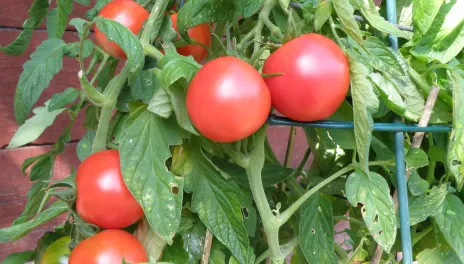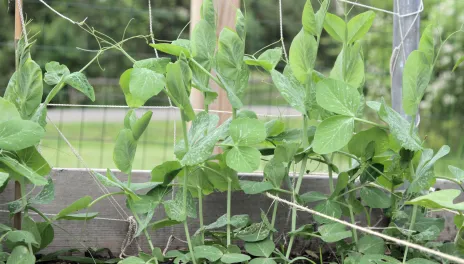Page Title
Vegetables
Banner

Sections
TOPICS
Page Portals
Vegetable and Herb Videos from Spring Garden Fever Forums
Vegetables Publications
One of the most important steps in establishing and growing lawns, vegetables, trees, and flowers is understanding soil health. This publication explains different soil textures and how to troubleshoot common problems. In addition, the…
Leafy greens include lettuce, spinach, Swiss chard, kale and arugula. They are easy to grow and prepare, and provide a wide variety of nutrients.
Many types of onions are available to grow and use. Onions are ranked sixth among the world’s leading vegetable crops. On average, people eat about 20 pounds of onions a year.
More than 5,000 varieties of potatoes are grown throughout the world. The average person in the U.S. eats 124 pounds of potatoes every year. Potatoes can be used in a wide variety of recipes.
Pumpkins are one of the colorful symbols of autumn. Most people think of using them solely for the purpose of carving and displaying, but pumpkin can be used in many ways on your menu, including soups and desserts. Try roasting the seeds…
Snap beans are delicious vegetables that are easy for people of all ages to grow. They are easy to preserve, so we can enjoy them year-round.
Sweet corn on the cob (or off the cob) is a tasty addition to meals. Corn, also called “maize,” is sold by color, not variety (white, yellow or bicolor). Corn can be preserved in different ways to be enjoyed year-round.
Botanically, a tomato is classified as a fruit because it has seeds and is derived from flower tissue. Nutritionists consider tomatoes to be “vegetables” on the menu. Tomatoes can be frozen, canned or dried, so we can enjoy them year-round.
Squash has been used as a nutritious food for thousands of years in North America. You might find buttercup, butternut, acorn and/or spaghetti squash in your local grocery store. Botanists consider squash to be a fruit, but it is used as a…
Beets can be red, purple, white, golden yellow and other colors. Varieties include Detroit Dark Red, Red Ace, Merlin, Early Wonder Tall Top, Cylindra, Bull’s Blood and Touchstone Gold. Their flavor varies from earthy to sweet.
B ell peppers come in different colors such as green, yellow, orange, red and even purple. Most bell peppers start out green, then mature and ripen the longer they stay on the vine. As bell peppers change in color, they also…
Cabbage varieties may grow as round, flattened or pointed heads. Regular irrigation is needed. If the plant does not get enough moisture from watering, it will taste bitter instead of being sweet, juicy and firm.
Did you know that carrots first were used as a medicine for a variety of ailments, not for eating? Carrots come in more colors than just orange. You can find purple, red, white and yellow varieties of this vegetable.
Popular slicing cucumber varieties include Summer Dance, Sweet Slice, Sweet Success, Tasty Green, General Lee and Straight Eight. Popular varieties for pickling include Homemade Pickles, Calypso and H-19 Little Leaf.
Garlic is easy to grow and adds flavor to recipes with few calories. It can be frozen or dried for later use.
Many cooks find garlic indispensable in the kitchen. Garlic is used to flavor salsa, stir-fry, spaghetti sauce, soups, stews, pickles, salads, salad dressing and breads.
This publication summarizes the benefits of gardening with children and provide information about basic garden preparation, tools and resources for parents/adults.
Determining how to purchase local food for retailers or businesses can be challenging.
This document busts the myths of local food purchasing and selling with guidance from the the North Dakota Department of Health and the North Dakota…
The purpose of this publication is to be used as a guide in growing and using herbs for culinary purposes.Plants that are referred to as "herbs" are not used as a good but are grown and consumed as a garnish, and for flavor enhancement,…
Pesticides can increase the quality and quantity of our food supply, prevent disease and improve the comfort and aesthetics of our environment. The use of pesticides is not without risks. Every pesticide applicator is responsible for…
Vegetable publications - Food preparation
Leafy greens include lettuce, spinach, Swiss chard, kale and arugula. They are easy to grow and prepare, and provide a wide variety of nutrients.
Many types of onions are available to grow and use. Onions are ranked sixth among the world’s leading vegetable crops. On average, people eat about 20 pounds of onions a year.
More than 5,000 varieties of potatoes are grown throughout the world. The average person in the U.S. eats 124 pounds of potatoes every year. Potatoes can be used in a wide variety of recipes.
Pumpkins are one of the colorful symbols of autumn. Most people think of using them solely for the purpose of carving and displaying, but pumpkin can be used in many ways on your menu, including soups and desserts. Try roasting the seeds…
Snap beans are delicious vegetables that are easy for people of all ages to grow. They are easy to preserve, so we can enjoy them year-round.
Botanically, a tomato is classified as a fruit because it has seeds and is derived from flower tissue. Nutritionists consider tomatoes to be “vegetables” on the menu. Tomatoes can be frozen, canned or dried, so we can enjoy them year-round.
Squash has been used as a nutritious food for thousands of years in North America. You might find buttercup, butternut, acorn and/or spaghetti squash in your local grocery store. Botanists consider squash to be a fruit, but it is used as a…
Beets can be red, purple, white, golden yellow and other colors. Varieties include Detroit Dark Red, Red Ace, Merlin, Early Wonder Tall Top, Cylindra, Bull’s Blood and Touchstone Gold. Their flavor varies from earthy to sweet.
B ell peppers come in different colors such as green, yellow, orange, red and even purple. Most bell peppers start out green, then mature and ripen the longer they stay on the vine. As bell peppers change in color, they also…
Cabbage varieties may grow as round, flattened or pointed heads. Regular irrigation is needed. If the plant does not get enough moisture from watering, it will taste bitter instead of being sweet, juicy and firm.
Vegetable Publications for Growing
One of the most important steps in establishing and growing lawns, vegetables, trees, and flowers is understanding soil health. This publication explains different soil textures and how to troubleshoot common problems. In addition, the…
Many cooks find garlic indispensable in the kitchen. Garlic is used to flavor salsa, stir-fry, spaghetti sauce, soups, stews, pickles, salads, salad dressing and breads.
The purpose of this publication is to be used as a guide in growing and using herbs for culinary purposes.Plants that are referred to as "herbs" are not used as a good but are grown and consumed as a garnish, and for flavor enhancement,…
Pesticides can increase the quality and quantity of our food supply, prevent disease and improve the comfort and aesthetics of our environment. The use of pesticides is not without risks. Every pesticide applicator is responsible for…
This publication summarizes the process of pollination in different vegetables and fruits grown by the backyard gardeners of North Dakota. Successful pollination is needed for fruit or berry production. The role of pollinators in growing…

